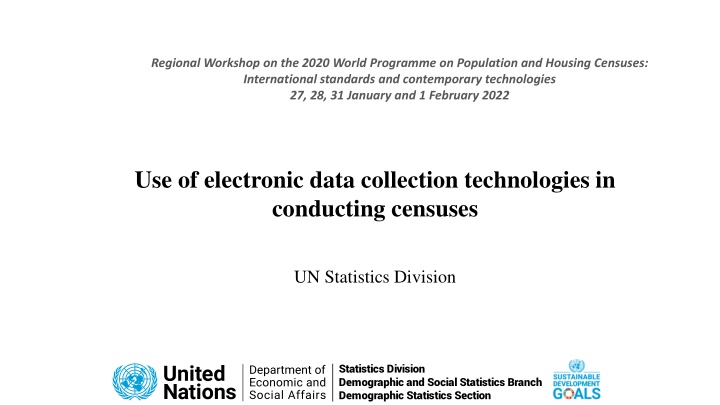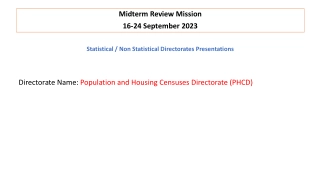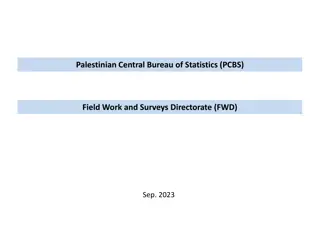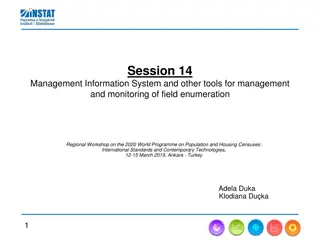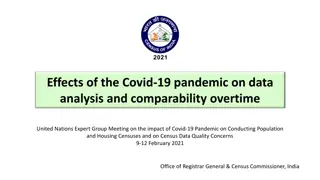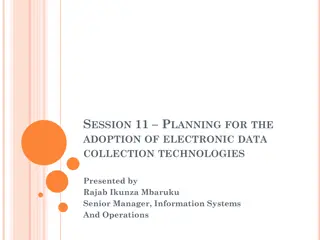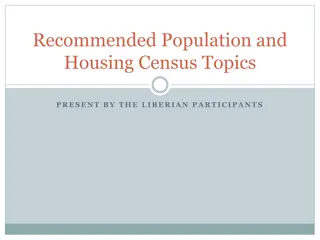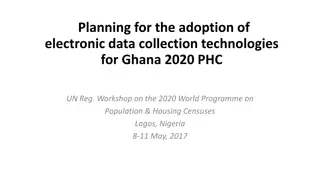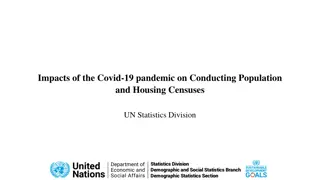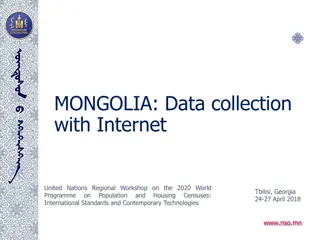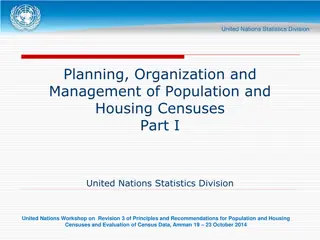Regional Workshop on Population and Housing Censuses: Electronic Data Collection Technologies
This discusses the use of electronic data collection technologies in conducting censuses, key drivers, information required for decision-making, and qualitative information essential for a successful census operation.
Uploaded on Mar 12, 2025 | 1 Views
Download Presentation

Please find below an Image/Link to download the presentation.
The content on the website is provided AS IS for your information and personal use only. It may not be sold, licensed, or shared on other websites without obtaining consent from the author.If you encounter any issues during the download, it is possible that the publisher has removed the file from their server.
You are allowed to download the files provided on this website for personal or commercial use, subject to the condition that they are used lawfully. All files are the property of their respective owners.
The content on the website is provided AS IS for your information and personal use only. It may not be sold, licensed, or shared on other websites without obtaining consent from the author.
E N D
Presentation Transcript
Regional Workshop on the 2020 World Programme on Population and Housing Censuses: International standards and contemporary technologies 27, 28, 31 January and 1 February 2022 Use of electronic data collection technologies in conducting censuses UN Statistics Division Statistics Division Demographic and Social Statistics Branch Demographic Statistics Section
Key drivers Demand for timely data Demand for better coverage and data quality Demand for improving the quality of operations-min. human errors Demand for minimizing response burden Less costs of technology and easy accessibility Demand for cost-effectiveness Opportunities for effective management and monitoring of field enumeration User and stakeholder expectation National and global commitments to modernization of statistical systems Statistics Division Demographic and Social Statistics Branch Demographic Statistics Section
Information required for decision making on the use of electronic data collection technologies Quantitative information Population size and density Literacy rate Proportion of population having basic computer skills Number and proportion of population who can access to the Internet Number and percentage of households with Internet connection Proportion of households with electricity Cellular/mobile phone coverage Pattern of non-response rates for previous censuses and surveys By geographical area and rural/urban Statistics Division Demographic and Social Statistics Branch Demographic Statistics Section
Information required for decision making on the use of electronic data collection technologies Qualitative information How ready is the statistical agency to adopt new technology for enumeration? How will Government and main stakeholders (particularly data users) react to the use of new technology? Does existing legislation allows for a change in the method of enumeration, and, if not, is a requisite change practicable? What is the public s reaction to adoption of Internet as the medium for self-response? What are main expected challenges? What would be strategies to achieve these challenges? What are the risks in procuring hardware and outsourced services? Statistics Division Demographic and Social Statistics Branch Demographic Statistics Section
Information required for decision making on the use of electronic data collection technologies Information needed for operational aspects The extent of the geographic area to be covered Number of days/weeks estimated to complete the enumeration Total population (in terms of person and households) to be counted Number of Enumeration Areas (EAs) Size of field force (enumerators and all supervisory staff) depending on method of data collection including multi-mode approach Availability and the quality of address frame or address registers Technology constraints (online/offline, power access) Outsourcing opportunity Non-response follow-up (anticipated level of non-response) Statistics Division Demographic and Social Statistics Branch Demographic Statistics Section
Information required for decision making Estimate of Total Cost of Ownership o Fixed costs and variable costs o Three components of TCO: - Hardware/ software - Operational costs - Personal costs o Total costs of the multi-mode can be assessed by adding the cost estimate of each possible method o Comparison with the costs of previous census Statistics Division Demographic and Social Statistics Branch Demographic Statistics Section
Information required for decision making Benefits- improving data quality, coverage, timeliness of delivery of outputs and future uses of same technology for statistical operations Risks and challenges- such as building a capacity, data transfer, resource mobilization, hiring a qualified field staff, data security Timetable- sufficient time such as for building a capacity, procurement, system development, end-to-end testing (usually extensions to the timetable required for decision making and planning) Reuse of technology- other censuses, household surveys, business registers, the use of hardware by other organizations Best practices-practices of countries which have similar conditions Statistics Division Demographic and Social Statistics Branch Demographic Statistics Section
Components of decision making Data collection mode(s): Understanding the data collection mode (or modes if a multi-mode approach is decided) is one of the first considerations. PAPI, PASI, CAPI, CASI, CATI or some combination of these be adopted? Type of hardware : Types of hardware (such as servers, handheld devices, tables or smartphones) needed for census operations should be decided Software development: Method of developing software and applications should be decided- (commercial, in-house, out- sourced, customized) Statistics Division Demographic and Social Statistics Branch Demographic Statistics Section
Management structure for decision making Decisions should be given through consultations with managers within the agency and with a variety of external stakeholders including technical experts, subject specialists and end users The high-level management group would be responsible body for making the decision An advisory board on technology would be responsible for reviewing types of technology available Technical working groups would be formed for specific areas such as IT, census methodology and field operation, census legislation, budget, procurement/outsourcing, logistics, etc. - more detailed research for possible alternatives Statistics Division Demographic and Social Statistics Branch Demographic Statistics Section
Use of computer-assistant personal interview (CAPI) Advantages Real-time quality control- implementation of built-in edits\ Improved questionnaire design- flexibility in space and language and supporting to respondents/enumerators Added features -integration with GPS, digital maps, help materials Improved field management real time monitoring Reduced time and possibility of reducing costs no data capture, less time for editing/imputation Disseminating timely and reliable information Statistics Division Demographic and Social Statistics Branch Demographic Statistics Section
Use of computer-assistant personal interview (CAPI) Challenges Redesigning census processes High cost of equipment More time needed for preparation Sufficient technical expertise Data and system security Infrastructure constraints Data transfer considerations Statistics Division Demographic and Social Statistics Branch Demographic Statistics Section
Use of computer-assistant personal interview (CAPI) Moving from PAPI to CAPI- Planning considerations Critical factors in planning o Census timetable o Government support and budget allocation o Capacity development for new technology o Modernization of IT infrastructure-central and regional o Development of systems and applications o Data transfer from field to head quarter and security o Decision on one mode or mixed modes of data collection Statistics Division Demographic and Social Statistics Branch Demographic Statistics Section
Use of computer-assistant personal interview (CAPI) Important features of handheld devices o Processor performance and operating system -should not affect the performance of enumerators and data collection application o Storage capacity usually no problem for hundreds of interviews, but requires careful review especially if multimedia features are employed o Screen affects costs and interview performance o Battery more duration is desirable, external batteries can be considered o Connectivity options Wi-Fi, Bluetooth, a cellular connectivity Features of devices that will be used by enumerators, supervisors, IT supervisors are same? Statistics Division Demographic and Social Statistics Branch Demographic Statistics Section
Use of computer-assistant personal interview (CAPI) Acquiring the device Outright purchase Best way for ensuring it fits with requirements of census operations but can be expensive Sharing/pooling among agencies/countries Jordan shared with Palestine, Malawi will share with Zambia (2020 census) Renting Bring your own device (BYOD)-not advised Statistics Division Demographic and Social Statistics Branch Demographic Statistics Section
Use of computer-assistant personal interview (CAPI) Essential features of CAPI Interface for field users Questionnaire navigation Automated routing (skipping) Precoding Customizing of questions (fill in a data from its memory) Data quality control (real-time editing) Case management (receive assignments, manage completeness and quality of questionnaire) Support and documentation Other features: collection of operational information (paradata) Statistics Division Demographic and Social Statistics Branch Demographic Statistics Section
Use of computer-assistant personal interview (CAPI) Development/acquisition of a CAPI system o In-house o Outsourcing o Configuring existing software o Off-the-shelf solution Statistics Division Demographic and Social Statistics Branch Demographic Statistics Section
Use of computer-assistant personal interview (CAPI) Security of data collected with handheld devices Measures to secure data o User and device authentication o Encryption of stored data o Device use policy-restrictions of particular applications to mobile device o Use of MDM (mobile device management) technologies Provide secure access to data transfer networks Can be tracked or remotely locked if devices are stolen Statistics Division Demographic and Social Statistics Branch Demographic Statistics Section
Use of computer-assistant self-interview (CAWI) Avantages o Improved coverage and data quality o Potential cost saving o Greater convenience and lower response burden o Improved timeliness o Protecting privacy o Other benefits (environmentally friendly, generating a large amount of metadata) Statistics Division Demographic and Social Statistics Branch Demographic Statistics Section
Use of computer-assistant self-interview (CAWI) Challenges Providing reliable linkage between household and location Coordination of multi-mode collection Developing systems infrastructure Protecting data security portal may be crashed/respondent data may be corrupted or lost Extended collection period (hard to capture picture as at census day) Mode effect and non-response bias High initial cost Statistics Division Demographic and Social Statistics Branch Demographic Statistics Section
Use of computer-assistant self-interview (CAWI) Requirements o High literacy rate o High level of access to computers and the Internet, and computer literacy o Making reasonable assumptions about take-up rate o Availability of address/building/dwelling list o Questionnaire design for mobile devices o Public trust and acceptance of Internet for official business Statistics Division Demographic and Social Statistics Branch Demographic Statistics Section
Use of computer-assistant self-interview (CAWI) A first step towards the use of Internet for future census Feasibility study to assess the success of internet collection to obtain a measure of: o Public acceptance o Take-up rate o Impact on overall response o Distribution of returns over the collection period o Data quality o Impact on field management o IT infrastructure requirements o Impact on response burden o Impact on under-enumeration or over count Statistics Division Demographic and Social Statistics Branch Demographic Statistics Section
Use of computer-assistant self-interview (CAWI) Planning phase should include: o Assessment of local circumstances o Review of international experience o Establishment of viable options o Preferred strategy, on technology and the balance between in- house work versus outsourced contracts o Risk analysis o Implementation plan o Short-term and long-term vision o Evaluation plan o Setting achievable targets Statistics Division Demographic and Social Statistics Branch Demographic Statistics Section
Use of computer-assistant self-interview (CAWI) Contact and communication strategy Multi-phase contact approach Offering a paper questionnaire o at initial contact or; o during the reminder phase or; o on request Choosing the best approach Communication strategy (invitation letter/reminder letters, etc.) Statistics Division Demographic and Social Statistics Branch Demographic Statistics Section
Use of computer-assistant self-interview (CAWI) Support for respondents o Online help o Frequently asked questions o Embedded help text in the online questionnaire o Questionnaire guide o Census helpline (Call Centre) Statistics Division Demographic and Social Statistics Branch Demographic Statistics Section
Use of computer-assistant self-interview (CAWI) Security To maintain security of personal information: o Secure log-in o Internet application should ensure zero footprint on respondent computer o Timing-out after period of inactivity o Encryption o Powerful firewalls, intrusion detection o Strong access control procedures o Contingency plans for temporary service interruptions o Communication strategies to assure respondents Statistics Division Demographic and Social Statistics Branch Demographic Statistics Section
Multi-mode data collection When electronic data collection method is used, more than one data collection mode might be necessary : o to improve coverage, in a cost-effective manner - Especially, to reach people difficult to enumerate, such as people living in remote areas or living in buildings difficult to access - Provide an alternative to people reluctant to participate Decision should be given through decision-making process to make sure it is cost- effective Statistics Division Demographic and Social Statistics Branch Demographic Statistics Section
Multi-mode data collection Multi-mode data collection can be designed using two different approaches: Sequential approach: All respondents are first requested to provide information in one particular mode only then are offered other modes to increase the response rate. One common practice is to start with the least expensive mode and then progress to more expensive and more persuasive modes o Concurrent approach: Respondents are offered, at the outset, the choice of one of two or more modes by which they can provide information. An example of a concurrent mixed-mode design is offering respondents the option of completing a paper questionnaire or providing information online via the Internet o Statistics Division Demographic and Social Statistics Branch Demographic Statistics Section
Multi-mode data collection Paper-based questionnaire Electronic questionnaire CAPI PAPI Multi-mode paper-based data collection Multi-mode electronic data collection CASI PASI CATI Mixed electronic /paper data collection Statistics Division Demographic and Social Statistics Branch Demographic Statistics Section
Main reference document : Guidelines on the Use of Electronic Data Collection Technologies in Population and Housing Censuses https://unstats.un.org/unsd/demographic/standmeth/handbooks/data- collection-census-201901.pdf Statistics Division Demographic and Social Statistics Branch Demographic Statistics Section
